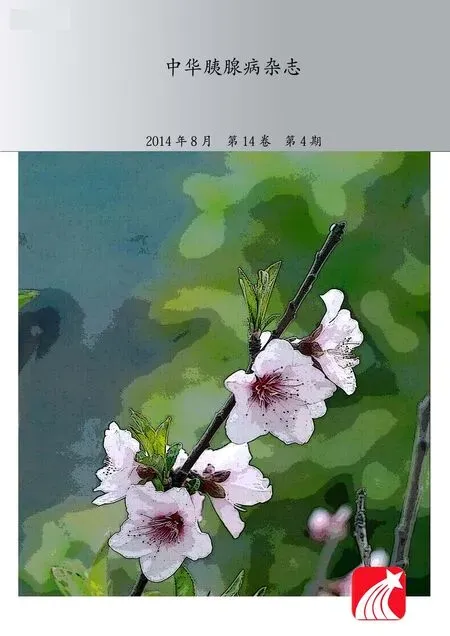双氯芬酸钠预防ERCP术后胰腺炎的机制
2014-08-04胡翠赵孝文鲍峻峻丁浩徐张巍刘晓昌梅俏许建明
胡翠 赵孝文 鲍峻峻 丁浩 徐张巍 刘晓昌 梅俏 许建明
内镜逆行胰胆管造影术(ERCP)最常见和最严重的并发症是术后胰腺炎(post-ERCP pancreatitis,PEP),发生率为1%~10%[1-2],高危患者发生率可达30%[3-5]。因此,预防PEP是临床研究的热点问题。研究表明,非甾体类抗炎药(NSAIDs)具有预防PEP的临床疗效[6]。Elmunzer等[7]和Dai等[8]的荟萃分析亦证实NSAIDs能降低PEP发生率。NSAIDs是通过促进NSAID激活基因(NSAID activated gene,NAG-1)的表达发挥抗炎作用。近年有研究证实,双氯芬酸钠同样具有预防PEP发生的作用[9]。本研究应用双氯芬酸钠防治PEP,观察患者血清NAG-1水平的变化,探讨其作用机制。
一、材料和方法
1.研究对象:收集2012年9月至2013年10月安徽医科大学第一附属医院消化内科行ERCP治疗的住院患者。入选标准:年龄>18岁,未合并心、肺、肝、肾疾病及凝血功能障碍,无NSAIDs药物禁忌证,术前未使用NSAIDs,术前影像学及血清学证实未合并胰腺炎。试验经医院伦理委员会批准,入选病例术前均签署知情同意书。按完全随机法分为双氯芬酸钠组和对照组,ERCP术后按常规处理,双氯芬酸钠组术后立即肌内注射奥尔芬(含双氯芬酸钠75 mg)1支。
2.PEP诊断标准:ERCP术后有新出现或者加重的腹痛,术后24 h血淀粉酶升高至少3倍,可诊断为PEP,单纯淀粉酶升高患者则为高淀粉酶血症。
3.血清淀粉酶活性、NAG-1水平检测:术前及术后3、24 h采集空腹静脉血2 ml,3 000 r/min离心15 min,分离血浆,置-80℃冰箱内保存待测。采用全自动生化检测仪测定血清淀粉酶活性,采用ELISA法检测血清NAG-1水平。

二、结果
1.一般情况:共纳入120例患者,其中男性56例,女性64例,年龄21~80岁,平均57岁。双氯芬酸钠组和对照组各60例,两组患者在年龄、性别、吸烟史、饮酒史和病因方面具有可比性。
2.两组患者术前、术后血清淀粉酶活性的变化及PEP发生率:两组患者术前淀粉酶活性差异无统计学意义,术后3、24 h,双氯芬酸钠组患者血清淀粉酶活性均显著低于同时间点对照组(t值分别为2.06、2.03,P值均<0.05,表1)。两组患者共16例(13.3%)发生PEP,其中双氯芬酸钠组4例(6.7%),对照组12例(20.0%),两组PEP发生率的差异有统计学意义(χ2=4.62,P=0.03)。

表1 两组患者ERCP术前、术后淀粉酶活性的比较
3.两组患者术前、术后血清NAG-1水平的变化:对照组患者术前、术后血清NAG-1水平无显著变化。双氯芬酸钠组患者术前血清NAG-1水平与对照组的差异无统计学意义;术后3 h的NAG-1水平较术前显著升高(F=4.30,P=0.04),也较同时间点对照组显著升高(t=2.54,P=0.01);术后24 h的NAG-1水平较术后3 h时显著下降(P=0.00),且恢复到术前水平(P=0.54。表2)。

表2 两组患者ERCP术前、术后血清NAG-1水平的变化
讨论PEP是ERCP术后最常见和最严重的并发症之一,如何预防PEP成为临床难题。国内外对防治PEP的药物[1]进行了大量研究,如奥曲肽[10]、别嘌呤醇[11]、肝素[12]等。研究证实,NSAIDs可以预防PEP的发生[6]。NSAIDs预防PEP的机制尚不完全清楚,可能是通过抑制前列腺素的合成和阻断胰腺炎的炎症级联反应来预防PEP的发生[13]。Mäkelä等[14]研究发现,NSAIDs可抑制重症急性胰腺炎患者血清PLA2活性及中性粒细胞/内皮细胞的黏附。Simon等[15]研究表明,NSAIDs可通过抑制中性粒细胞活化,减轻PEP的炎症程度。
Senol等[16]研究发现,ERCP术后立即肌内注射75 mg双氯酚酸钠,PEP发生率及术后4、8、24 h血淀粉酶值与对照组相比无显著差别,但对未合并Oddi括约肌功能障碍的患者,双氯酚酸钠可显著降低其PEP发生率。Murray等[17]研究表明,ERCP术后立即直肠给予双氯芬酸,PEP发生率显著降低(6.36%比15.5%)。本研究结果显示,给予双氯芬酸钠的患者术后血淀粉酶活性显著下降,PEP的发生率也显著下降,提示ERCP术后立即注射双氯芬酸钠可以预防PEP的发生。
NAG-1是TGF-β超家族的重要成员之一,是从吲哚美辛处理的结肠癌细胞中通过PCR消减杂交技术获取,可通过抑制环氧化物酶途径抑制结肠肿瘤的进展。NAG-1在炎症发生过程中表达增加[18],可以降低脂多糖引起的炎症反应[19],同时,通过降低巨噬细胞TNF-α的分泌水平,发挥显著抗炎作用[20]。NSAIDs对NAG-1的表达具有重要影响[21-22]。
本研究结果显示,双氯芬酸钠组术后血清NAG-1水平显著高于对照组,表明双氯芬酸钠可通过诱导NAG-1的表达,从而减轻炎症反应。
参 考 文 献
[1] Cooper ST, Slivka A. Incidence, risk factors, and prevention of post-ERCP pancreatitis[J]. Gastroenterol Clin North Am, 2007,36(2): 259-276.
[2] Murray B, Carter R, Imrie C, et al. Diclofenac reduces the incidence of acute pancreatitis after endoscopic retrograde cholangiopancreatography[J]. Gastroenterology, 2003, 124(7): 1786-1791.
[3] Andriulli A, Loperfdo S, Napolitano G, et al. Incidence rates of post-ERCP complications: a systematic survey of prospective studies[J]. Am J Gastroenterol, 2007, 102(8): 1781-1788.
[4] Freeman ML, Guda NM. Prevention of post-ERCP pancreatitis: a comprehensive review[J]. Gastrointest Endosc, 2004, 59(7): 845-864.
[5] Cotton PB, Garrow DA, Gallagher J, et al. Risk factors for complication after ERCP: a multivariate analysis of 11497 procedures over 12 years[J]. Gastrontest Endosc, 2009, 70(1): 80-88.
[6] Elmunzer BJ, Scheiman JM, Lehman GA, et al. A randomized trial of rectal indomethacin to prevent post-ERCP pancreatitis[J]. N Engl J Med, 2012, 366(15): 1414-1422.
[7] Elmunzer BJ, Waljee AK,Elta GH, et al. A meta-analysis of rectal NSAIDs in the prevention of post-ERCP pancreatitis[J]. Gut, 2008,57(9):1262-1267.
[8] Dai HF, Wang XW, Zhao K. Role of nonsteroidal anti-inflammatory drugs in the prevention of post-ERCP pancreatitis: a meta-analysis[J]. Hepatobiliary Pancreat Dis Int,2009,8(1):11-16.
[9] Cheon YK, Cho KB, Watkins JL,et al. Efficacy of diclofenac in the prevention of post-ERCP pancreatitis in predominantly high-risk patients: a randomized double-blind prospective trial[J]. Gastrointest Endosc, 2007, 66: 1126-1132.
[10] Kisli E, Baser M, Aydin M, et al. The role of octreotide versus placebo in the prevention of post-ERCP pancreatitis[J]. Hepatogastroenterology, 2007, 54(73):250-253.
[11] Mosler P, Sherman S, Marks J, et al. Oral allopurinol does not prevent the frequency or the severity of post-ERCP pancreatitis[J]. Gastrointest Endosc, 2005,62(2):245-250.
[12] Rabenstein T, Fischer B, Wiessner V, et al. Low-molecular-weight heparin does not prevent acute post-ERCP pancreatitis[J]. Gastrointest Endosc, 2004,59(6):606-613.
[13] Wagh MS, Sherman S. Indomethacin for post-ERCP pancreatitis prophylaxis: another attempt at the Holy Grail[J]. Am J Gastroenterol, 2007, 102(5): 984-986.
[14] Mäkelä A, Kuusi T, Schröder T. Inhibition of serum phospholipase-A2 in acute pancreatitis by pharmacological agents in vitro[J]. Scand J Clin Lab Invest, 1997, 57(5): 401-407.
[15] Simon LS. Actions and toxicity of nonsteroidal antiinflammatory drugs[J]. Curr Opin Rheumatol, 1996, 8(3): 169-175.
[16] Senol A, Saritas U, Demirkan H. Efficacy of intramuscular diclofenac and fluid replacement in prevention of post-ERCP pancreatitis[J]. World J Gastroenterol, 2009, 15(32): 3999-4004.
[17] Murray B, Carter R, Imrie C,et al. Diclofenac reduces the incidence of acute pancreatitis after endoscopic retrograde cholangiopancreatography[J]. Gastroenterology, 2003, 124(7): 1786-1791.
[18] Eling TE, Baek SJ, Shim M, et al. NSAID Activated Gene (NAG-1), a Modulator of Tumorigenesis[J]. J Biochem Mol Biol, 2006,39(6):649-655.
[19] Kim JM, Kosak JP, Kim JK, et al. NAG-1/GDF-15 transgenic mouse has less white adipose tissue and a reduced inflammatory response[J]. Mediators Inflamm, 2013,2013:641851.
[20] Bootcov MR, Bauskin AR, Valenzuela SM, et al. MIC-1, a novel macrophage inhibitory cytokine, is a divergent member of the TGF-beta superfamily[J]. Proc Natl Acad Sci USA, 1997,94(21):11514-11519.
[21] Baek SJ,Kim KS,Nixon JB,et al. Cyclooxygenase inhibitors regulate the expression of a TGF-beta superfamily mcmber that has proapoptotic and antitumorigenic activities[J]. Mol Pharmacol, 2001, 59(4): 901-908.
[22] Baek SJ, Kim KS, Jenniffer B, et al. Cyclooxygenase inhibitors regulate the expression of a TGF-beta superfamily member that has proapoptotic and antitumorigenic activities[J]. Mol Pharmacol, 2001, 59(4):901-908.
